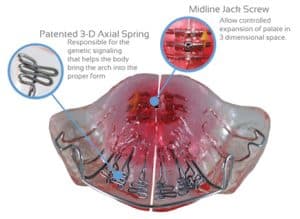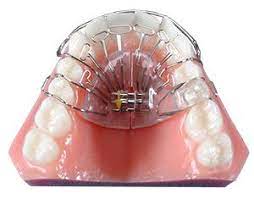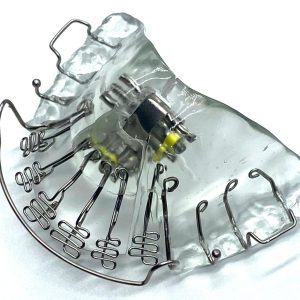The DNA Appliance is Similar to the Homeoblock

The Homeoblock is the godfather of all adult palatal expanders. It has been in use for over 30 years. The DNA and the Homeoblock look very similar in appearance with the exception of the different spring shapes. Both appliances look like a combination of a retainer, nightguard and palatal expander. Dr Singh and Dr Belfor invented the DNA and Homeoblock appliances, respectively. The similarities are not surprising because Dr. Singh and Dr. Belfor used to work together for years. The rumor has it, that there was a falling out. And shortly thereafter, came the DNA appliance.
Homeoblock vs DNA Appliance
The Homeoblock appliance is very similar to the DNA appliance. In fact, the Homeblock can be designed exactly as a DNA appliance if so prescribed by the doctor. The Homeoblock appliance was invented by Dr. Belfor. Dr. Belfor practiced in NY city for years and years. He is in his 80s and still does tons of research and personally manages the Homeoblock project. He actively participates in design and fabrication of the appliances. He also still trains dentists interested in using the Homeoblock. The Homeoblock looks like the DNA appliance. The Homeoblock may be better than the DNA in cases where there are more facial asymmetries and cranial strains. The DNA and Homeoblock appliances are both adapted Schwarz devices with a special spring and bite plane area.
How DNA and Homeoblock Adult Palatal Expanders Work

What is Different About the Homeoblock:
The Homeoblock works by stimulating bone growth with a unilateral bite block. The theory is everyone has one side of their face that is under developed more than the other. The bite block is classically placed on the weaker side and stimulates bone to start growing. The Homeoblock can also be designed with a bilateral bite block by the provider. The Homeoblock is custom designed to address the individual needs of each patient. The device is highly customizable and versatile. We see the same results with similar designs in the DNA and Homeoblock appliances. What really makes the difference is the experience of the provider, not whether the DNA or Homeoblock is used. We use both and several other expanders as well.
What is Different About the DNA Appliance:
The DNA appliance was originally invented by Dr. Singh. The DNA is the most popular palatal expander for adults. The technology has been purchased by Vivos.com The DNA has a sister appliance called the mRNA appliance which is a combination of a DNA appliance and a mandibular repositioning appliance. The DNA device is the most versatile of all adult expanders. It is the most comfortable adult appliance too. The Homeoblock device is very similar to the DNA and it is equally comfortable and works the same as the Vivos DNA appliance.
Dr. Singh and Vivos Therapeutics
Dr. Singh is employed by Vivos Therapeutics, but he is not involved in the day to day designs of the appliances or the management of the business. In fact, no one outside of Vivos really knows what he does. Perhaps nothing. He did well when he sold his the DNA to Vivos.
Vivos has invested millions into public marketing and awareness about how dental appliances can correct sleep apnea. They have not endorsed the appliance as one for TMJ, though it is very effective in treating the symptoms of TMJ. Seems like a huge missed marketing opportunity since pain is one of the most powerful motivators on earth.
Breathing and Myofunctional Therapy are important and critical to DNA and Homeoblock appliance success. Dr. Singh and Belfor believe this. The tongue has the biggest roles in growth of the face and obstructive airway conditions.
What is Myofunctional Therapy?
Myofunctional therapy is basically physical therapy for tongues. Tongue function is evaluated. Exercises are given to improve tongue:
- Range of motion
- Strength and muscle tone
- Swallow patterns
- Tongue posture flush on the palate
- Participation during healthy breathing patterns
When a tongue tie causes the tongue not to function properly, a qualified dentist and myofunctional therapist will order a functional tongue untie procedure. A functional procedure verifies the tongue can move properly during the surgical procedure. Laser assisted techniques are done quickly, painlessly and without any bleeding. Success of the procedure hinges on the the tongue being untied and the patient performing myofunctional tongue exercises after the procedure.
Mouth Breathing vs Nose Breathing
Nasal breathing promotes healthy growth and development starting at a very young age. Nose breathing uses muscle groups in the abdomen, ribs, shoulders, neck and face. Healthy coordinated muscle patterns during breathing support good upright comfortable posture.
Mouth breathing uses a different muscle pattern than nasal breathing. Mouth breathing causes people to slouch and have forward head posture. People who mouth breath end up with small jaws, crooked teeth, poor airways, bad posture, sleep problems and bruxism. This is because muscle patterns used during mouth breathing causes the bones in the face, chest, back and neck to grow to be the wrong size and shape. Muscle pressure stimulates our bones to grow to a certain size and shape.
What is the role of the tongue?
The tongue puts pressure on the upper jaw and teeth. The pressure promotes growth of a wider palate wider palate and upper jaw. The hard palate forms the base of the nose. As the palate grows wider, people can fit more air through larger nasal spaces. If enough oxygen fits through nasal spaces, it is not necessary to open the mouth to breathe. If the nasal passageways are too small, the mouth will need to open to meet oxygen demands.

